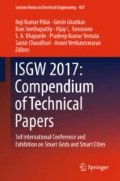Abstract
Forecasting of power generation is an essential requirement for high penetration of variable renewable energy in existing grid system as the major purpose of forecasting is to reduce the uncertainty of renewable generation, so that its variability can be more precisely accommodated. This paper focuses on the statistical behaviour of error in solar and wind power forecasting considering Indian regulations and analyses the applicability of the error limit in calculating the energy accuracy of forecasting and the stability of the grid.
Access this chapter
Tax calculation will be finalised at checkout
Purchases are for personal use only
References
National Action Plan on Climate Change, GOI. http://www.moef.nic.in/downloads/home/Pg01-52.pdf. Last visited on 30 Sept 2016
India’s Intended Nationally Determined Contribution: Working Towards Climate Justice. http://www4.unfccc.int/submissions/INDC/Published%20Documents/India/1/INDIA%20INDC%20TO%20UNFCCC.pdf. Last visited on 30 Sept 2016
Report of the Expert Group on 175 GW RE by 2022, NITI Aayog, GOI. http://niti.gov.in/writereaddata/files/writereaddata/files/document_publication/report-175-GW-RE.pdf. Last visited on 30 Sept 2016
Strategic plan for new and renewable energy sector for the period 2011–17, Ministry of New and Renewable Energy, Government of India, 2011
Das Abhik Kumar (2015) An analytical model for ratio based analysis of wind power ramp events. Sustain Energy Technol Assess 9:49–54
Mazumdar BM, Saquib M, Das AK (2014) An empirical model for ramp analysis of utility-scale solar PV power. Solar Energy 107:44–49
Kamath C (2010) Understanding wind ramp events through analysis of historical data. In: Transmission and distribution conference and exposition, 2010 IEEE PES in New Orleans, LA, United States, April 2010
Das AK, Majumder BM (2013) Statistical model for wind power based on ramp analysis. Int J Green Energy
Gallego C, Costa A, Cuerva A, Landberg L, Greaves B, Collins J (2013) A wavelet-based approach for large wind power ramp characterisation. Wind Energy 16(2):257–278
Bosavy A, Girad R, Kariniotakis G (2013) Forecasting ramps of wind power production with numerical weather prediction ensembles. Wind Energy 16(1):51–63
Kirby B, Milligan M (2008) An exemption of capacity and ramping impacts of wind energy on power systems. Electr J 2(7):30–42
Steffel SJ (2010) Distribution grid considerations for large scale solar and wind installations. In: IEEE, 1–3, transmission and distribution conference and exposition, 2010 IEEE PES
Das AK (2016) Forecasting and scheduling of wind and solar power generation in India. In: NTPC’s 3rd international technology summit. Global Energy Technology Summit 2016
Indian Electricity Grid Code, Central Electricity Regulatory Commission, 2010. http://cercind.gov.in/2010/ORDER/February2010/IEGC_Review_Proposal.pdf. Last visited on 30 Sept 2016
Procedure for implementation of the mechanism of Renewable Regulatory Fund, Central Electricity Regulatory Commission. http://www.cercind.gov.in/Regulations/Detailed_Procedure_IEGC.pdf. Last visited on 30 Sept 2016
Framework on Forecasting, Scheduling and Imbalance Handling for Variable Renewable Energy Sources (Wind and Solar), Central Electricity Regulatory Commission. http://www.cercind.gov.in/2015/regulation/SOR7.pdf. Last visited on 30 Sept 2016
Model Regulations on Forecasting, Scheduling and Deviation Settlement of Wind and Solar Generating Stations at the State level. http://www.forumofregulators.gov.in/Data/study/MR.pdf. Last visited on 30 Sept 2016
Das AK (2014) Quantifying photovoltaic power variability using Lorenz curve. J Renew Sustain Energy, AIP 6(3):033124
Author information
Authors and Affiliations
Corresponding author
Editor information
Editors and Affiliations
Appendix
Appendix
For a good forecasting system, we can consider \(\overline{{x_{S} }} \to \overline{{x_{A} }}\) and \(\sigma_{A} \to \sigma_{S}\). Hence, using the no-penalty band in Table 1, for some n we can state that
\(= \sigma_{A}^{2} + \sigma_{S}^{2} - 2r\sigma_{A} \sigma_{S} = 2(1 - r)\sigma_{A}^{2} ,\) which implies (3).
Integrating, we get
Using (8), \(P(m) = 1 - \exp ( - \lambda m)\) and for exponential distribution \(\sigma_{e} = 1/\lambda .\) Hence, replacing \(\exp ( - \lambda m)\) and λ, we get (7).
Rights and permissions
Copyright information
© 2018 Springer Nature Singapore Pte Ltd.
About this paper
Cite this paper
Das, A.K. (2018). Applicability of Error Limit in Forecasting and Scheduling of Wind and Solar Power in India. In: Pillai, R., et al. ISGW 2017: Compendium of Technical Papers. Lecture Notes in Electrical Engineering, vol 487. Springer, Singapore. https://doi.org/10.1007/978-981-10-8249-8_23
Download citation
DOI: https://doi.org/10.1007/978-981-10-8249-8_23
Published:
Publisher Name: Springer, Singapore
Print ISBN: 978-981-10-8248-1
Online ISBN: 978-981-10-8249-8
eBook Packages: EnergyEnergy (R0)

